![]()
![]()
![]()
Use LEFT and RIGHT arrow keys to navigate between flashcards;
Use UP and DOWN arrow keys to flip the card;
H to show hint;
A reads text to speech;
11 Cards in this Set
- Front
- Back
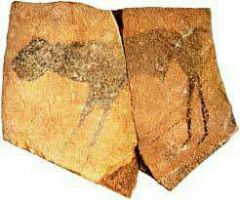
|
N. Apollo 11 Stones D. 23,000 BCE P/S. Prehistoric/ Paleolithic. Middle Stone Age A. Unknown OL. Huns Mountains of Namibia, Africa P. Not Applicable M/T. Charcoal Paint onto Stone F. Recreation of Animals Convincingly Definition of the animal capturing its essence DT. Knowledge and belief, drawing, total of seven stone fragments, oldest dated art known on the African continent . Art Mobilier C. Historic/ prehistoric shows how human advancement is able to recognize and document what they see. Was buried on the floor of the cave by layers until 1969. Estimated time of when it was created was possible through radiocarbon dating. To express their thoughts of their surrounding. An animal resembling a feline. The legs were added later. The horns resemble an oryx. |
|

|
N. Great Hall of the Bulls D. 15,000 BCE P/S. Prehistoric/ Paleolithic A. Unknown OL. Lascaux, France P. Not Applicable M/T. Different paint at different times F. Archeologist assume rituals took place in front of the paintings DT. Twisted Perspective/ Composite View, used a groud line. Bodies were depicted in profile while we see the horns in a more frontal viewpoint. Artist planned our the works C. Historical, shows how Human advancement with ground line, twisted perspective to try to document realistically the bull. Some walls have holes that supported tree-limb scaffolding that would have elevated an artist high enough to reach the upper surfaces. Breuli Theory: images played a role in “hunting magic". People who used the cave may have believed that a way to over power their pray involved creating images of it during rituals designed to ensure a successful hunt. Second Theory: images communicate narratives. |
|
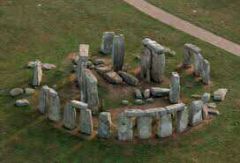
|
N. Stonehenge D. 2550- 1600 BCE P/S. Prehistoric; Neolithic A. Unknown OL. Wiltshire, England P. Not Applicable M/T. Megalithic Stones, Rough Cut Sarsen and Blue Stones F. Pagan worship/ calendar system DT. Trilithons, five pairs knowledge and belief. Henge: circular ditch and bank together. Ditch is about 6 ft. Deep and bank of dirt is 360 ft. In diameter. Three Phases of construction.13 feet high, almost seven feet wide and weighed around 25 tons. C. Great controversy about how it was made; henge; used basic form of construction, megalith, trilothons. Phase 1: occurred around 3100 BCE, a six feet deep circular ditch was dug with a bank of earth in it, around 360 feet in diameter. Entrance on the northeast and south. 56 pits within the henge. Thought to be originally filled with upright blue stones or upright wooden beams Phase 2: 100-200 years later, set up of upright wooden posts, possibly of a roofed structure, in the center of the henge, as well as more upright posts near the northeast and southern entrances. during this phase it was used for burial. adult males, aged 25-40 years Phase 3: 400-500 years later, blue stones or wooden beams which had been placed in the Aubrey holes were pulled |
|
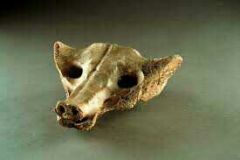
|
N. Camelid Sacrum in the Shape of a Canine D. 14,000-7,000 B.C.E. P/S. Prehistoric A. Unknown OL. Tequixquiac, Mexico P. Unknown M/T. Sacrum bone (base of the spine) of a camelid and transformed into a canine head; made from the now fossilized remains of the sacrum of an extinct camelid, F. Possibly used for religious ceremonies revolving around fertility DT. Carved, bones rough, spiritual, symbolic. Large triangular bone. Engraved. Polish at the end of the cuts. Perfectly symmetrical nostrils. C. Possibly religious, used as a mask , traditionally thought to be simultaneously located in an other world. Holes were cut into the end to represent nostrils. Date is difficult to determine because proper stratigraphic analysis was not done when the object was discovered. The object was in private hands between 1895-1956. Bone relates to sacredness, to resurrection, and to fire |
|
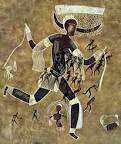
|
N. Running Horned Woman D. 6,000- 4,000 B.C.E. P/S. Prehistoric A. Unknown OL. Tassili n'Ajjer, Algeria P. N/A M/T. Rock Painting, F. Ritual/Ceremonial Context DT. Rock wall, Pigments, supernatural beings, symbolic C. On the rock walls and displays rarred human and animal activities The resulting undercuts at cliff bases have created rock shelters with smooth walls ideal for painting. some previous methods of recording and/or documenting have caused damage to the vibrancy and integrity of the images. |
|
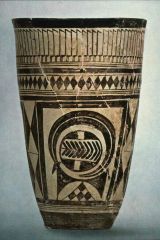
|
N. Beaker with Ibex Motifs D. 4,200-3,500 B.C.E. P/S. Prehistoric (between Neolithic and historic era) A. Unknown OL. Susan, Iran P. N/A M/T. Clay, hand painting , glazed after painted F. Burial purposed, however has no records of the exact function DT. Stylized, Geometric, C.
|
|
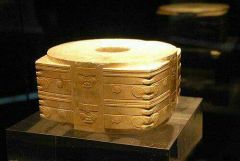
|
N. Jade Cong D. 3,300-2,200 B.C.E. P/S. Neolithic A. Unknown OL. China P. N/A M/T. Jade stone. worked with a hard abrasive sand F. Unknown, placed in burial tombs DT. square outer section around a circular inner part. face pattern; refer to spirits or deities. derived from a combination of a man-like figure and a mysterious beast. enigmatic. C. Grand burials for the elite from which a wealth of objects have been excavated. buried in large numbers. made at many stages of the Neolithic and early historic period, |
|

|
N. The Ambum Stone D. 1,500 B.C.E. P/S. Neolithic. Prehistoric A. Unknown OL. Pacific Islands P. Unknown M/T. working with the tough greywacke stone would have involved many weeks of laborious chipping and hammering at the surface with stone tools. F. Obscure. considered sacred and credited with supernatural powers by present-day people in the region, where they are used as spirit stones in sorcery and other rituals. DT. nose tip resembles that of a fruit bat. spiny anteater), an animal thought to have been revered for its useful fat deposits prior to the introduction of pigs. C. One of the earliest known Pacific works of art. Ancient stone mortars and pestles from Papua New Guinea are often fashioned into the forms of birds, humans and animals. little is known about the people who produced this beautiful work |
|
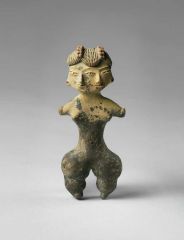
|
N. Tlatilco Female Figurine D. 1,200-900 B.C.E. P/S. Middle Preclassic, Prehistoric A. Unknown OL. Central Mexico P. Unknown M/T. Ceramic with traces of pigment, F. difficult to know exactly why the artist depicted a bicephalic. Theory: interested in expressing an idea of duality DT. intimate, lively poses, elaborate hairstyles, emphasis on the wide hips, the spherical upper thighs, and the pinched waist, show no interest in the hands or feet, rare C. Characteristics indicate sophisticated artistic tradition. hair and its styling was important for the people of Tlatilco, as it was for many peoples of this region. makers lived in a large farming villages. |
|

|
N. Terra Cotta Fragment D. 1,000 B.C.E. P/S. Prehistoric, Neolithic A. Unkown, Lapita people OL. P. M/T. Terra Cotta F. Ceramic tradition DT. patterns were incised into the pots before firing with a comblike tool used to stamp designs into the wet clay. Each stamp consisted of a single design element that was combined with others to form elaborate patterns. C. finest examples of the Lapita potter's art, this fragment depicts a human face incorporated into the intricate geometric designs characteristic of the Lapita ceramic tradition. |
|

|
N. Anthromorphic Stele from Ha’il D. 4000-3000 B.C.E. P/S. Prehistoric, Neolithic A. Unknown OL. Saudi Arabia P. Unknown M/T. sandstone. Exogenous materials F. each region, village, and tribe is believed to differ in custom and to have developed strong local traditions. probably associated with religious or burial practices, likely used as a grave marker in an open-air sanctuary. Also used for dedication, commemoration, and demarcation. DT. Three feet High. Free standing stone. Human-like. Sculpted on both sides. emphasis is on the front, particularly the face, chest, and waist. Trapezoidal head sits on squared shoulders. Closely spaced eyes, flattened nose. necklace hangs with two cords diagonally crossing the body with an awl. double-bladed dagger hangs from a wide belt that continues around to the back. Stylized. Male figure. C. groups of hunter-gatherers gradually shifted their economy from predation to production by domesticating such herd animals as sheep, goats, and cattle, and settling in oases and mountainous regions linked to one another by caravan trails. Inhabitants migrated to different areas. confirm that during the Neolithic period objects were circulated and exchanged across wide swathes of territory. existence of a pre-Islamic Arabia in which the human figure dominates. |

